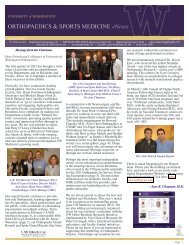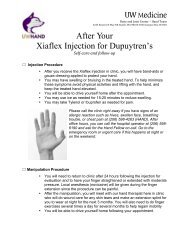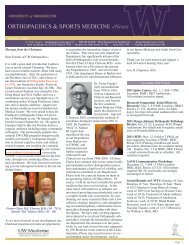2002 - University of Washington Bone and Joint Sources
2002 - University of Washington Bone and Joint Sources
2002 - University of Washington Bone and Joint Sources
Create successful ePaper yourself
Turn your PDF publications into a flip-book with our unique Google optimized e-Paper software.
The Quality <strong>of</strong> Life Outcomes Following Total Shoulder<br />
Arthroplasty are Comparable to Those <strong>of</strong> Total Hip Arthroplasty<br />
<strong>and</strong> Coronary Artery Bypass Grafting<br />
RICHARD S. BOORMAN, M.D., M.SC., BRANKO KOPJAR, M.D., PH.D., EDWARD FEHRINGER, M.D.,<br />
R. SEAN CHURCHILL, M.D., KEVIN L. SMITH, M.D., AND FREDERICK A. MATSEN III, M.D.<br />
Arthritis <strong>of</strong> the shoulder can<br />
substantially compromise a<br />
patient’s general health status<br />
(Matsen et al, 2000). The goal <strong>of</strong> an<br />
arthroplasty is to improve not only the<br />
function <strong>of</strong> the joint, but also the<br />
patient’s overall health <strong>and</strong> well being.<br />
Health-related quality <strong>of</strong> life, selfassessment<br />
questionnaires have been<br />
used to document these results (Hozak<br />
et al, 1997). The Medical Outcomes<br />
Study Short-Form 36 (SF-36)<br />
questionnaire is particularly useful in<br />
this regard <strong>and</strong> has been used<br />
extensively in various patient groups<br />
(Ware, 1993). This questionnaire has<br />
been tested for validity <strong>and</strong> reliability,<br />
<strong>and</strong> population control results are<br />
published.<br />
Total shoulder arthroplasty (TSA)<br />
is the procedure <strong>of</strong> choice for managing<br />
patients with advanced glenohumeral<br />
osteoarthritis, however the degree to<br />
which shoulder arthroplasty improves<br />
the longer-term quality <strong>of</strong> life remains<br />
undefined. Furthermore, the relative<br />
effectiveness <strong>of</strong> shoulder arthroplasty in<br />
comparison to other common surgical<br />
interventions is unknown.<br />
The purpose <strong>of</strong> this study was (1)<br />
to evaluate the impact <strong>of</strong> TSA on the<br />
SF-36 in patients with glenohumeral<br />
osteoarthritis several years after surgery,<br />
(2) to compare the SF-36 scores for<br />
patients before <strong>and</strong> after TSA to those<br />
from a control population, <strong>and</strong> (3) to<br />
compare the results <strong>of</strong> TSA to the<br />
results <strong>of</strong> other effective orthopaedic<br />
<strong>and</strong> cardiac surgical procedures.<br />
METHODS AND MATERIALS<br />
One hundred <strong>and</strong> thirteen patients<br />
with primary glenohumeral<br />
osteoarthritis were treated with<br />
primary total shoulder arthroplasty<br />
(TSA) by an individual surgeon (FAM)<br />
between January 1, 1993 <strong>and</strong> December<br />
31, 1997. All patients completed the SF-<br />
36 before surgery, <strong>and</strong> at 6-month<br />
intervals post-operatively. Eighty-five<br />
patients were men <strong>and</strong> twenty-seven<br />
were women. Thirteen patients (12%)<br />
underwent bilateral total shoulder<br />
arthroplasties during that time. For<br />
these thirteen patients only the<br />
information related to the first operated<br />
shoulder was included in the analysis.<br />
A total <strong>of</strong> ninety-one patients had<br />
followup SF-36 data collected during<br />
the 30-60 month time frame after<br />
surgery. The mean <strong>of</strong> the 6 monthly<br />
interval scores for each dimension,<br />
reported in the 30-60 month time<br />
window, for each patient, was used as<br />
the post-operative score for statistical<br />
comparison.<br />
Postoperative values for SF-36<br />
dimensions were compared with<br />
preoperative values by using a paired<br />
t-test. Further, patients’ SF-36 scores<br />
were compared by paired t-test to those<br />
<strong>of</strong> age- <strong>and</strong> gender-matched general<br />
population controls reported in the<br />
literature. All analyses were performed<br />
using SPSS 10.0 for Windows.<br />
A Medline search was performed to<br />
find articles that report SF-36 results<br />
both pre-operatively <strong>and</strong> postoperatively,<br />
<strong>and</strong> at least one year<br />
following total hip replacement <strong>and</strong><br />
coronary bypass procedures. The<br />
average score weighted by sample size<br />
for each dimension from all studies that<br />
met our inclusion criteria were then<br />
calculated for both the THA patients<br />
<strong>and</strong> the CABG patients. These<br />
weighted average scores were compared<br />
to the TSA data from this study.<br />
100<br />
90<br />
80<br />
70<br />
60<br />
50<br />
40<br />
30<br />
20<br />
10<br />
0<br />
Physical<br />
Function<br />
Social<br />
Function<br />
Physical<br />
Role<br />
Emotional<br />
Role<br />
Mental<br />
Health<br />
Preoperative<br />
Postoperative<br />
Controls<br />
Energy Comfort General<br />
Health<br />
Figure 1: Preoperative <strong>and</strong> postoperative SF-36 scores for total shoulder arthroplasty compared age<strong>and</strong><br />
gender-matched data from control populations.<br />
RESULTS<br />
The average age <strong>of</strong> the patients in<br />
the study group was 64 years (S.D. = 10<br />
years), 62 years (S.D. = 10 years) among<br />
the seventy-two men <strong>and</strong> 73 years (S.D.<br />
= 7 years) among the nineteen women<br />
(p < .01). The ninety-one patients for<br />
whom 30-60 month followup data were<br />
available were not significantly different<br />
from the 22 patients for whom data in<br />
this time window were not available<br />
with respect to age, gender, or<br />
preoperative health status. Patients<br />
improved statistically significantly in<br />
the following SF-36 dimensions:<br />
physical role function (p















